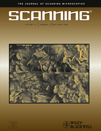A method to measure the total scattering cross section and effective beam gas path length in a low-vacuum SEM
Abstract
A method is presented to determine the total scattering cross section of imaging gases used in low-vacuum scanning electron microscopy or environmental scanning electron microscopy. Experimental results are presented for water vapor, nitrogen gas and ambient air for primary beam electron energies between 5 and 30 keV. The measured results are compared and discussed with calculated values. This method allows the effective beam gas path length (BGPL) to be determined. The variations of the effective BGPL with varying chamber pressure are presented. SCANNING 31: 107–113, 2009. © 2009 Wiley Periodicals, Inc.




